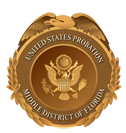Supervision is a court ordered sentence issued as an alternative to jail or prison. Individuals under supervision are assigned to a probation officer who is responsible for monitoring offenders and ensuring they comply with the conditions the court set for their release to the community.
Suprevision in the federal system is:
- A core responsibility of U.S. probation and pretrial services officers, along with investigation.
- A way to monitor the activities and behavior of people released to the community by the federal courts or paroling authorities.
- An opportunity to help offenders reintegrate into the community following a period of incarceration.
- In the case of probation, a punishment that is less severe than imprisonment, but still holds people accountable for breaking the law.
- An alternative to jail or prison that costs less than incarceration and gives people charged with or convicted of federal crimes the opportunity to live with their families, hold jobs, and be productive members of society.
As a component of the federal judiciary responsible for community corrections, the federal probation and pretrial services system is fundamentally committed to protecting the public and assisting in the fair administration of justice.
United States probation officers are community corrections professionals who serve as officers of the court and as agents of the U.S. Parole Commission. They are responsible for the supervision of persons conditionally released to the community by the courts, the Parole Commission, Federal Bureau of Prisons, and military authorities. Officers recommend, implement and monitor offenders' compliance with the conditions of release; and work with offenders to facilitate their reintegration into the community as law abiding and productive members of society.
Supervision is a dynamic process throughout which officers are to keep informed and––consistent with the conditions of release and individual circumstances––intervene with strategies designed to manage risk and provide offenders with the tools and social services they may require to succeed. It is through such intervention in higher risk cases that officers further the goal of public safety during the period of supervision and beyond.
Officers carry out these responsibilities by assessing the risks, needs and strengths of each offender to determine the appropriate level of supervision; and then utilizing skills from various disciplines to simultaneously monitor and, as necessary, control and correct offender behavior. These include the investigation skills of law enforcement, but to the primary purpose of planning for success rather than documenting failure. They include the treatment and service delivery skills of social workers, but with a primary focus on improving circumstances that are linked to criminal behavior (e.g., substance abuse; mental health; employment; education; family/community support).
Officers maintain awareness and, depending on the circumstances and conditions in the case, implement restrictive and correctional strategies to encourage pro-social behavior and facilitate positive change. This multidimensional role does not mean that each officer is expected to be an expert in all areas. Rather, officers are to serve as participating case managers, both aware of their own strengths and limitations, and knowledgeable of the range of expertise available in their offices and communities.
Officers exercise their authority judiciously, using only those supervision strategies that are sufficient, but not greater than necessary, to accomplish sentencing purposes in the individual case. They treat all offenders, colleagues, and community partners with dignity and respect. Establishing rapport and maintaining a dialogue with offenders, family members, employers, community service providers and others is the fundamental work of the supervision officer. Listening and inquiring are his or her primary tools.
The supervision mission is to execute the sentence, to protect the community by reducing the risk and recurrence of crime, and to maximize offender success during the period of supervision and beyond.
The goal in all cases is the successful completion of the term of supervision during which the offender commits no new crimes, is held accountable for victim, family and community responsibilities, and prepares for continued success through improvements in his or her conduct and condition.
Conditions of Supervised Release
At the start of an offender’s community supervision, a probation officer will fully explain to an offender the conditions of his or her release. These conditions include the mandatory conditions of release which the court imposes on all offenders, and may include discretionary conditions which the court imposes to provide probation officers with the authority to address risk related issues specific to a particular offender. Discretionary conditions may include, among other things, home detention, substance abuse testing or treatment, mental health treatment, and the disclosure of financial information.
Process of Supervision
The process of supervising an offender begins with a probation officer evaluating the offender through an interview and risk assessment tool, which allows the officer to identify factors that must be taken into account in developing the offender’s individualized supervision plan. From the start and throughout supervision, the officer will assess and reassess the potential risk that an offender poses to the community, and address the offender's other needs. Continued assessments allow the probation officer to adjust his or her personal contact and interventions with the offender accordingly. The supervision plan developed by the officer will address any obstacles that may impede an offender’s ability or desire to complete supervision successfully and will provide for services, such as substance abuse or mental health treatment that the offender may require.
